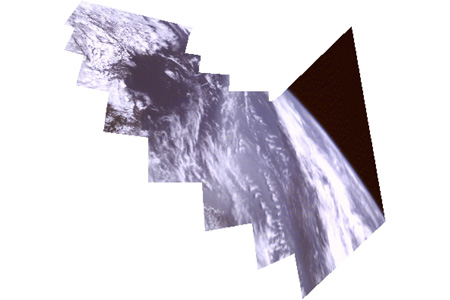HUNTINGTON BEACH, Calif., March 04, 2009 -- The Boeing [NYSE: BA] demonstration picosatellite CubeSat TestBed 1 (CSTB1) today surpassed 10,000 Earth orbits since its launch on April 17, 2007.
After completing its original mission goals of operating for six months in space and supporting three months of tests, the spacecraft, which is smaller than a standard toaster, continues to operate and provide engineers with data that is increasing the industry's knowledge and validation of various miniature satellite designs, technologies and systems.
Boeing Advanced Network and Space Systems, developer of CSTB1, is exploring new ways to reduce the size, weight and power of satellite technologies needed for operational NanoSats -- spacecraft weighing less than 22 pounds (10 kg). Picosatellites such as CSTB1 weigh less than 2.2 pounds (1 kg).
"The breakthroughs we've made with CSTB1 are enabling us to advance the development of NanoSat capabilities," said Scott MacGillivray, program manager for Boeing Nano-Satellite Programs and CSTB1. "We've downloaded more than 1 million data points to date, including dozens of photographs by CSTB1's small camera with a lens the size of a pencil's eraser head, and we continue to receive data on the extended-life characteristics of key components."
"Our success in demonstrating this new capability shows how NanoSats can perform valuable tasks to support Operationally Responsive Space needs," said Alex Lopez, vice president, Boeing Advanced Network and Space Systems. "As interest in NanoSats continues to grow, our accomplishments position us well to offer customers an affordable, viable option for specific satellite missions."
Weighing a little less than two pounds (approximately 900 grams), CSTB1 consists of four microcontrollers as the brains, redundant communication systems with two independent radios, two high-capacity lithium-ion rechargeable batteries, a deployable antenna, a sophisticated control system that determines the attitude of the spacecraft using sun and magnetic-field sensors, a simple attitude control system that uses magnetic torque coils, and multifunctional boards containing sensors and electronics.
NanoSats could potentially perform functions similar to larger satellites, while requiring significantly less time and cost to produce. Their low cost allows for more innovative approaches to be used due to the higher tolerance for risk.
The tiny spacecraft are quickly deployable to launch sites and remote areas and can be integrated into a launch vehicle without dedicated manifesting -- they can "piggyback" on a rocket carrying other payloads.
With the on-orbit success of CSTB1, large spacecraft developers, both government and commercial, today have a low-cost, quick-response capability for testing small components and subsystems in space early on in the development phase.
Boeing's next CubeSat demonstration mission, CSTB3, will be the first of a family of spacecraft designs representative of Boeing's new Tensor small-spacecraft avionics architecture, which will be the core of a wide array of missions.
CSTB3 is larger (approximately 4 kg and 10x10x30 cm) than CSTB1 and will demonstrate larger spacecraft capabilities such as higher communications bandwidth, three-axis control, onboard autonomy, and advanced dynamic power management. CSTB3 is expected to be flight-ready this summer.
Additional Boeing-developed NanoSat technologies ready for flight include:
- Miniature, low-power Star Tracker for precision attitude knowledge
- Multithruster propulsion module for orbit maneuvering/maintenance
- Nano-reaction wheel assembly for precision attitude control
- Complete Attitude Determination & Control subsystem
- Extensible electrical power collection and distribution subsystem that supports satellite sizes ranging from picosatellites (<1 kg) to microsatellites (<50 kg)
- Command & Data Handling subsystem
- A variety of NanoSat components to enable operationally relevant missions.
 USA
USA

